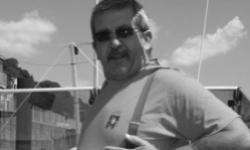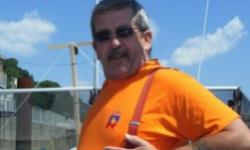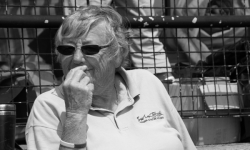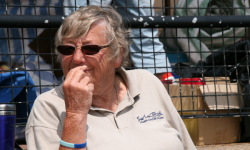07 Sep 2012Bliss for Bayliss who sets new A2A world record
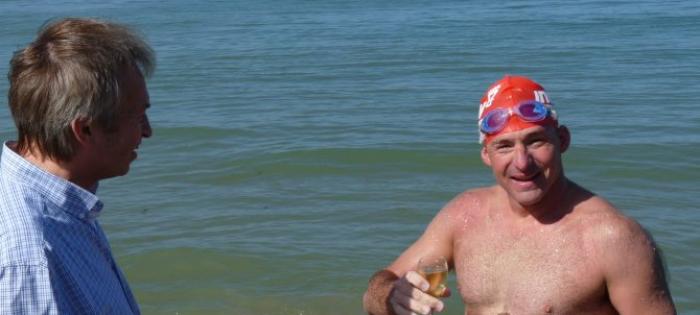
Mark Bayliss drinks champagne on way to knocking more than five hours off world record for London to Paris triathlon
Mark Bayliss became the world’s fastest person to complete an ultra endurance triathlon from London’s Marble Arch to the Arc de Triomphe in Paris on Sunday 9 September, writes John Tierney. Bayliss from Croydon was the 11th person to have completed the “Arch 2 Arc” and is the only competitor who has achieved the feat without having donned a wetsuit to swim the English Channel. In accordance with ‘English Channel Rules’ he did not wear a wetsuit during his swim leg of the race across the English Channel.
Organised by Enduroman, the race from Arch to Arc is simple in concept; run from London to Dover, swim to France and then cycle to Paris in the shortest possible time. “There’s no knowledge base for this kind of event” says Bayliss who ran 87 miles, swam 21 miles and cycled 181 miles en route to smashing five hours off the previous best time by a swimmer with a wetsuit. Bayliss took 73 hours 39 minutes and 12 seconds to cover the distance.
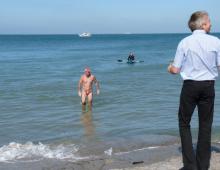
Mark finishing his swim
The Arch 2 Arc was first achieved by Eddie Ette in 2001. Six other men and three women have also succeeded. Explaining his motive for taking part, Bayliss said “I do these challenges because I get bored and they just keep getting bigger. The Arch to Arc came about from swimming the Channel and then running the Marathon Des Sables – it’s just putting the two together.”
The 35 year-old Bayliss swam the Channel in 11 hours and 48 minutes, just 16 minutes slower than his solo swim of September 2007. Again, Bayliss teamed up with CS&PF boat pilot Eddie Spelling and his boat ‘Anastasia’ to start from Shakespeare beach. “The swim, I loved it, it was the best bit of the whole event, especially the night-time swimming when it was dark. I loved every second. It was a moonlit night and it was absolutely beautiful. People don’t realise how lovely it is, and then you get to see the sun rise like no one else.”
As for the technicalities, Bayliss reckoned that his swim stroke rate was slow. “It’s usually 50-something (strokes per minute) but I wouldn’t have a clue. I had feed intervals every 45 minutes with Maxim and then alternating with either a banana, mini Wispa or jelly babies.” His feel for the water was such that he needed no company. “I had no swimmers join in with me in the water. I would not even think of it.”
Bayliss had a bubbly French arrival in Cap Gris Nez, France outside the famous La Sirene (The Mermaid) restaurant. “You’ll like this he said. “When I landed at the cap I was greeted by restaurateur Jean François Bouloy giving me a glass of champagne.”
Prior to the swim, Bayliss had to tackle the significant matter of running more than three marathons in succession to get from Marble Arch to Dover. A slippery start at Marble Arch followed by a non-chafing finish was his priority. On his pre-run preparations Bayliss commented that he “had done a lot of Ultras, so I know what happens, so I had a lot of Vaseline going on. It didn’t look too pretty as I was driven up towards Marble Arch with my hand down my trousers.” Bayliss’ approach included running barefoot style with very thin Inuit socks covering each individual toe, then normal running socks and a pair of Inov8 barefoot technology style shoes. “I started my running career in racing flats rather than normal shoes years ago. These shoes suit me down to the ground. I’ve no back problems and no I don’t get injured.”
The first half of Bayliss’ run was at 15 minute mile pace, and after a food break he extended to 18 minutes per mile. The route will remain etched on his memory forever as he mentally reeled off the names; “Marble Arch, Vauxhall, Oval, Peckham, New Cross, Lewisham, Sidcup, Brands Hatch and finally the A20 to Dover.” He had no supporting runner but did have a support car which leapfrogged him after every mile of his run. His modest thoughts of the run were that “the hardest bit was twilight on the morning; everything else was a job to do. I was just getting from A to B.” On reaching Dover and the bust of Capt Matthew Webb, the first man to swim the English Channel, I asked if he touched the great man’s face and Bayliss responded “at that point all I wanted to do was get some sleep, it had been a long old trot.”
Food consumption for the event was vital and interestingly, Bayliss opted for natural products instead of energy drinks where possible. “Firstly I had a stop about halfway at the Maidstone area, where a couple of hot jacket potatoes and cheese were brought to me. In terms of the general ticking over of the diet going down there, it was rice cakes with strawberry jam, plain bagels with honey, cereal bars, buttered malt loaf and lots of water. Apart from when I was swimming, everything else was real.”
His T1 transition required rest between the run and the swim. “I was asleep by 3pm and awake again at 9pm to get myself sorted for the 2:30am swim. I actually got into the water at 02:50am. Bayliss’ swimming career is impressive. “I’m very much a swimmer first” was how Bayliss qualified which leg of his Arch2Arc triathlon he preferred the most. His recent swimming portfolio includes a hat-trick of Lake Zurich swims from 2008-10, a 2011 English Channel relay and a summer of swimming in Dover harbour. His early years included representing England in the Home Nations water polo matches at under 18 level. He has played water polo for Sutton & Cheam, Portobello, Croydon Amphibians, Jersey and more. “I was always fit so I played more of a sweeper type role, someone who tidied up all the problems.”
His T2 transition involved returning an empty glass of champagne to Monsieur Bouloy and then making his way to the bike start. “We took about an hour to get up to Calais to unload. I grabbed a little bit of kip, then went to a restaurant for mussels, chips and coke and was then on my bike three hours and 22 minutes after finishing my swim.” Bayliss used an American manufactured ParleeTT bike and cycling through the night, arrived in world record time in Paris just before lunchtime.
Despite working a 65 hour week running a transport company, Bayliss made certain plans for the Arch2Arc. “I signed up for this in March 2010 and expected to go on 5 September this year and I did. I had a fair idea of the route but I didn’t rehearse the route at all.” With a height of 1.77metres, Bayliss maintained his steady weight of 93kgs whilst training 15-20 hours weekly. “I use the gym twice a week, and train most evenings and pretty much all weekend. I trained bloody hard for it and it was just completing a job that I expected of myself.” And his form of celebration was a drive to a local restaurant for dinner with his wife Lucinda.
Bayliss’ future plans include the 105 mile Spine running race across Yorkshire’s Pennine Way in January 2013. He will also swim round Jersey in August 2013. “It’s 48 miles to run the loop, but this will be tidal assisted, so very nice.”
To glean some tips and to understand the mindset of the new world record holder, Bayliss said that “I always advise people to be patient, because it will come. Yeah, patience it does work, and to be strong. In terms of training, to be stronger than you have ever been before. Because if your body is not going to break, it’s all down to your mind.”
Sandettie Lightship Observations
2am, 4th December 2025
Water: 53.2 °F (11.8 °C)
Air: 45.7 °F (7.6 °C)
Wind Speed: 20.0 kn (37.0 km/h)
Wind Direction: SSE (160°)
The CS&PF President, Mike Ball and all the committee are deeply saddened by the passing of Ady Brown.… https://t.co/E17pLxZwgw
3 years ago




